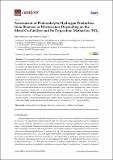Por favor, use este identificador para citar o enlazar a este item:
http://hdl.handle.net/10261/186926COMPARTIR / EXPORTAR:
 SHARE SHARE
 CORE
BASE CORE
BASE
|
|
| Visualizar otros formatos: MARC | Dublin Core | RDF | ORE | MODS | METS | DIDL | DATACITE | |

| Título: | Assessment of photocatalytic hydrogen production from biomass or wastewaters depending on the metal Co-Catalyst and its deposition method on TiO2 |
Autor: | Imizcoz, Mikel; Puga, Alberto V. | Palabras clave: | Photocatalysis Hydrogen Biomass Wastewaters Cellulose Rice husks |
Fecha de publicación: | 3-jul-2019 | Editor: | Multidisciplinary Digital Publishing Institute | Citación: | Catalysts 9(7): 584 (2019) | Resumen: | A systematic study on the solar photocatalytic hydrogen production (photoreforming) performance of M/TiO2 (M = Au, Ag, Cu or Pt) using glucose as a model substrate, and further extended to lignocellulose hydrolysates and wastewaters, is herein presented. Three metal (M) co-catalyst loading methods were tested. Variation of the type of metal results in significantly dissimilar H2 production rates, albeit the loading method exerts an even greater effect in most cases. Deposition-precipitation (followed by hydrogenation) or photodeposition provided better results than classical impregnation (followed by calcination). Interestingly, copper as a co-catalyst performed satisfactorily as compared to Au, and slightly below Pt, thus representing a realistic inexpensive alternative to noble metals. Hydrolysates of either α-cellulose or rice husks, obtained under mild conditions (short thermal cycles at 160 °C), were rich in saccharides and thus suitable as feedstocks. Nonetheless, the presence of inhibiting byproducts hindered H2 production. A novel photocatalytic UV pre-treatment method was successful to initially remove the most recalcitrant portion of these minor products along with H2 production (17 µmol gcat−1 h−1 on Cu/TiO2). After a short UV step, simulated sunlight photoreforming was orders of magnitude more efficient than without the pre-treatment. Hydrogen production was also directly tested on two different wastewater streams, that is, a municipal influent and samples from operations in a fruit juice producing plant, with remarkable results obtained for the latter (up to 115 µmol gcat−1 h−1 using Au/TiO2). | Descripción: | © 2019 by the authors. | Versión del editor: | https://doi.org/10.3390/catal9070584 | URI: | http://hdl.handle.net/10261/186926 | DOI: | 10.3390/catal9070584 | ISSN: | 2073-4344 | E-ISSN: | 2073-4344 |
| Aparece en las colecciones: | (ITQ) Artículos |
Ficheros en este ítem:
| Fichero | Descripción | Tamaño | Formato | |
|---|---|---|---|---|
| Assessment_Imizcoz_Art2019.pdf | 2,31 MB | Adobe PDF |  Visualizar/Abrir |
CORE Recommender
SCOPUSTM
Citations
48
checked on 22-abr-2024
WEB OF SCIENCETM
Citations
42
checked on 28-feb-2024
Page view(s)
223
checked on 24-abr-2024
Download(s)
335
checked on 24-abr-2024
Google ScholarTM
Check
Altmetric
Altmetric
Este item está licenciado bajo una Licencia Creative Commons

